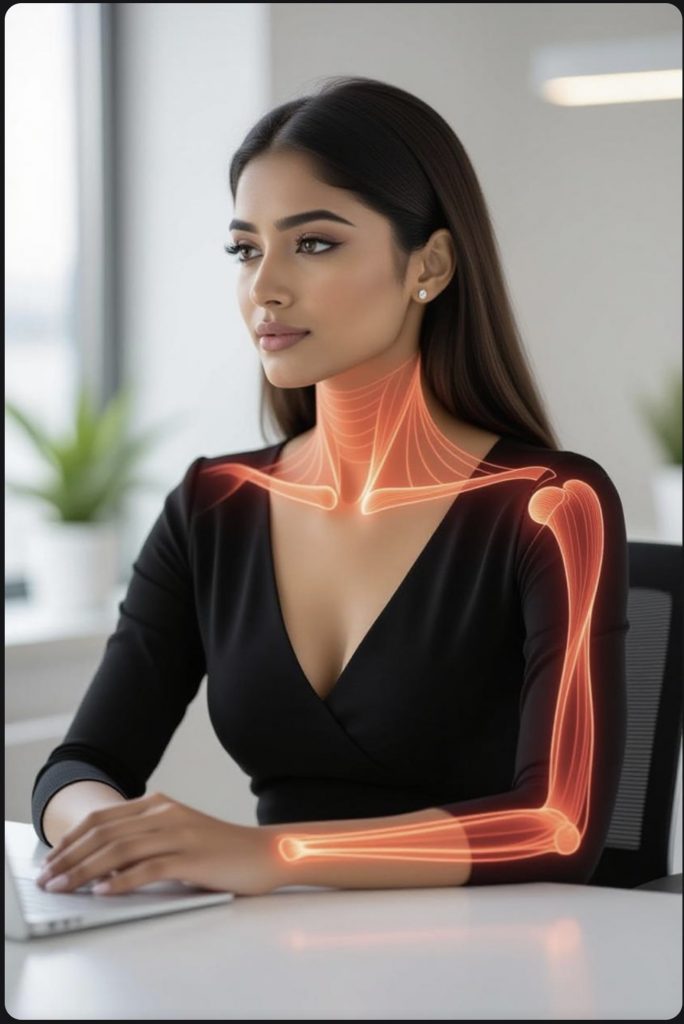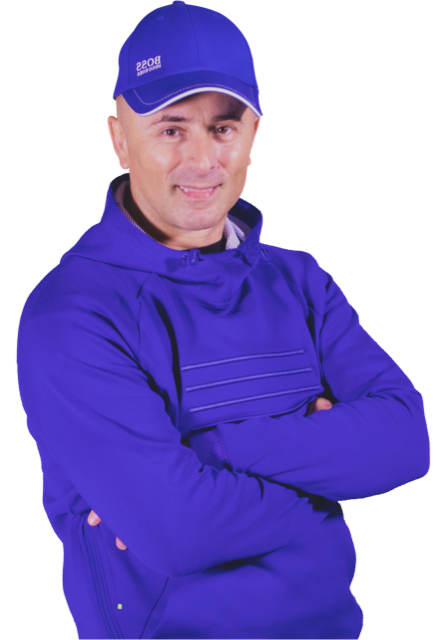One of the most typical questions people ask at Massaggi is ‘Why do my neck and shoulders hurt?’ If you’re suffering from aching, painful shoulders, neck stiffness, or neck pain, and possibly headaches too, then these conditions are common causes of tension headaches. Although neck and shoulder pain can have many causes, they often stem primarily from poor work posture and stress.
It is one of the most common, yet aggravating and easy-to-treat, sets of conditions found in the modern-day work environment.
Surprisingly, the human body is not designed to sit in the same position for eight hours a day. But before you go and tell your boss what you think of them, and jump on a jet plane for an extended break, there are some fundamental and easy-to-follow principles you can learn, which could also help you understand why your neck and shoulders hurt.
At the bottom of this quandary is usually one word – movement. The simple reason most of us suffer from these aches and pains is a lack of movement. In short, your body is designed for movement. When it doesn’t move for long periods, it becomes unhappy, starts complaining, and that’s when you feel ‘pain’.

What causes stiff, aching muscles?
A strong, thin film of connective tissue called ‘fascia’ coats our muscles. If you’ve ever prepared chicken, you might recall removing the skin from the bird and noticing the membrane covering all the muscles. That’s fascia. In addition to covering the entire muscle, it also encompasses all the individual muscle fibres. In fact, our ‘muscle’ is nothing more than a type of protein paste, and fascia encapsulates that paste, much like a sausage, to form individual, microscopic muscle fibres. These, in turn, are coated with more fascia, which binds all the ‘sausages’ together to form what you see as a big ‘muscle’.
Following so far? Now, as you can imagine, every time our muscles move, the fascia gets worn down. To maintain our structure, it needs to grow constantly. Which is all well and good in a healthy, moving body – it grows, it gets worn down, and so on. But in a body that isn’t moving? Well, that’s where the drama really starts.
But how does that make my neck and shoulders hurt?
You’re sitting at your desk, slumped over the computer in the same position you’ve been in all day. The muscles aren’t moving, yet the fascia continues to grow. As we now know, the fascia isn’t being ‘worn down’ by movement. As it continues to grow, it further restricts movement in already stiff areas. It’s not getting lubricated, so it becomes dry and forms a hard, compact substance.
Furthermore, muscle waste, such as lactic acid, also gets trapped. You now have a big, nasty traffic jam going on. And we all know how painful they can be! Does it make sense why your neck and shoulders hurt?
What is the best treatment if my neck and shoulders hurt?
Well, the cause of the pain is a lack of movement. Therefore, it stands to reason that the solution here might be movement—experimenting with regular exercise of those muscles. Get up, go and get a drink of water. Slowly shrug your shoulders – both forwards and backwards. Slowly rotate your neck by looking to the left, then to the right. Then slowly look down, taking your chin to your chest.
Everything should be done slowly, whilst remembering to breathe, and taking care to really feel what you are doing. Try shutting your eyes when you do it – this will heighten your senses surrounding your body awareness. You’ll probably notice that your neck and shoulders hurt, so be kind to yourself and move slowly, progressively, and gently. Often, people describe pain as ‘right’ or ‘wrong. If it feels like a ‘wrong’ pain, then you must STOP, and consult a Doctor or other medical professional.
And once you’ve gone through these basic movements, get creative. You don’t have to launch into a full-on dance routine in the middle of the office, but you can explore where your restrictions are and see how they feel when you slowly stretch them.
It may all feel clunky at first. You’ll probably wonder if you’re doing it right. But keep trying, it’s an experiential learning process.’

What is my keyboard/work position/desk height? Are they essential factors?
Yes! You must be comfortable at your desk. The angle of your seat, the height of your desk, and even the type of keyboard you use can all contribute to pain. Here’s a great article on setting up an ergonomic workstation!
What about sports massage? Do I need a deep tissue massage? Or will all of these tips be enough?
Sometimes it’s as simple as learning how to move the body – and the techniques described above will suffice. But sometimes your body will be so ‘set’ in a cycle of dysfunction that it will have created further imbalances and weaknesses. At Massaggi, we offer Sports Massage in London. We have many years of experience treating stiff necks and shoulders, and we show our clients easy stretches and relaxing exercises that will ease pain and help restore function. If the sports massage and deep tissue massage treatments we provide are not providing a lasting solution, we will examine why and refer to another specialist where appropriate. We never want you to return for a sports massage unnecessarily, as our clients will verify!
How to relieve your stiff neck and shoulders?
Many people wonder if sports massage or deep tissue massage can help alleviate their neck pain. Stiff neck and shoulders are often accompanied by RSI (Repetitive Strain Injury) pain in the arms. Sometimes there’s numbness in the fingers, too. In other words, the type of scenario that’s built up from long, stressful hours at the desk.
Sports massage can certainly help relieve stiff necks and shoulders; however, there are other things you can do to help yourself, which will work on their own and help consolidate the benefits of a sports massage. Find out here how to relieve a stiff neck and shoulders in 6 easy ways.
1. Move
A straightforward reason often causes stiff neck and shoulders – lack of movement. So move! Slowly shrug and rotate your shoulders, turn your head left and right and then slowly bring your chin to your chest. Do it all very sloooowly. Try to be kind and gentle to yourself, and really feel it!
2. Drink water
Working all day long dehydrates our bodies. Dehydration makes the muscles stiffer than usual because our bodies need water to lubricate movement, so drink plenty of water.
3. Have regular breaks
Combine a ‘movement break’ (see number 1) with a ‘water break’ (see number 2) in your daily routine. Try to take a break at least every hour, even if it’s just a short walk for a glass of water. Eventually, it will become second nature. When it becomes second nature, even the male of our species can multitask, often stretching his shoulders while looking at the computer screen simultaneously. C’mon, fellas – let’s show those girls our multitasking ninja moves.
4. Have a hot bath/use a heat pack or hot water bottle
Heat will bring fresh blood to the stiff areas. It will relax, lengthen, and loosen tight muscles, allowing for more movement. Take a microwavable heat pack to work – and when you get home, run a hot bath. But don’t fall asleep, wake up in a cold bath and be back at square one.
5. Stretch
Think of pussycats. Do they need stretching manuals? Do they ‘time’ their stretches? No. They ‘feel’ what’s going on in their bodies. If it feels nice, they carry on. If it hurts, they stop. Begin to bring a ‘kindly awareness’ to your body. Breathe into the stiff areas, being gentle yet thorough. Always remember to breathe. If you feel you want to explore further, Yoga can be a fantastic way to develop a new relationship with your body – maybe try out a few different classes until you find one that’s right for you!
6. Get a sports massage
Even if you’ve done all of the above and persuaded your other half to give you a shoulder rub, the chances are (especially if you’ve left it too long) that your stiff neck and shoulders will mean you need a professional to get into those difficult spots. Go to a sports and remedial massage therapist. Please make sure they’re reputable and qualified. If you live in the UK, ensure they hold a Level 4 or 5 qualification and are a member of a professional organisation that is contactable. If the therapist has a website, review their testimonials before scheduling an appointment.
